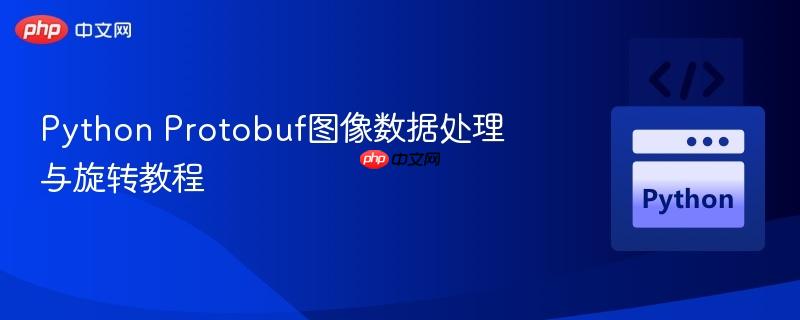
本教程旨在帮助开发者理解如何在Python中使用protobuf处理图像数据,特别是如何将protobuf中以bytes形式存储的图像数据转换为可操作的矩阵,并进行旋转操作。文章将详细介绍如何解析protobuf定义的图像结构,将bytes数据转换为图像矩阵,实现图像旋转,并将旋转后的数据重新封装为protobuf格式,同时提供示例代码和注意事项,助你轻松掌握protobuf图像处理的关键技术。
在protobuf中,图像数据通常以bytes类型存储,同时包含图像的宽度、高度以及是否为彩色图像等信息。 理解这些信息对于正确处理图像数据至关重要。以下是protobuf定义的Image消息的结构:
message Image {
bool color = 1;
bytes data = 2;
int32 width = 3;
int32 height = 4;
}其中:
关键在于如何将bytes类型的数据转换为可操作的图像矩阵。根据图像是否为彩色图像,转换方式有所不同。
立即学习“Python免费学习笔记(深入)”;
对于灰度图像,每个像素由一个字节表示。因此,可以将bytes数据直接转换为一个二维数组,其中每个元素代表一个像素的灰度值。
def bytes_to_grayscale_matrix(image):
width = image.width
height = image.height
data = image.data
matrix = []
for i in range(height):
row = []
for j in range(width):
row.append(data[i * width + j])
matrix.append(row)
return matrix对于彩色图像,每个像素由三个字节表示,分别代表红色、绿色和蓝色分量(RGB)。因此,需要将bytes数据按照每三个字节一组进行分割,并将每组数据转换为一个包含三个元素的元组。
def bytes_to_rgb_matrix(image):
width = image.width
height = image.height
data = image.data
matrix = []
for i in range(height):
row = []
for j in range(width):
index = (i * width + j) * 3
row.append((data[index], data[index + 1], data[index + 2]))
matrix.append(row)
return matrix图像旋转的核心在于对图像矩阵进行旋转操作。以下代码展示了如何将图像矩阵逆时针旋转90度:
def rotate_matrix_90(matrix):
return [list(row) for row in zip(*matrix[::-1])]可以根据需要实现其他角度的旋转,例如180度和270度。
旋转图像后,需要将旋转后的矩阵转换回bytes类型的数据,以便将其封装到protobuf消息中。
对于灰度图像,只需将矩阵中的所有元素依次添加到bytes对象中即可。
def grayscale_matrix_to_bytes(matrix):
data = bytearray()
for row in matrix:
for pixel in row:
data.append(pixel)
return bytes(data)对于彩色图像,需要将每个像素的RGB分量依次添加到bytes对象中。
def rgb_matrix_to_bytes(matrix):
data = bytearray()
for row in matrix:
for pixel in row:
data.append(pixel[0])
data.append(pixel[1])
data.append(pixel[2])
return bytes(data)以下是一个完整的示例代码,展示了如何使用protobuf处理图像数据并进行旋转操作:
import grpc
import image_pb2
import image_pb2_grpc
from concurrent import futures
# gRPC service implementation
class ImageService(image_pb2_grpc.ImageServiceServicer):
def RotateImage(self, request, context):
# Ensure that the number of bytes matches expection: width*height*bytes(color)
# Where bytes(color) = 1 (false) and 3 (true)
got = request.image.width * request.image.height * (3 if request.image.color else 1)
want = len(request.image.data)
if got != want:
context.set_code(grpc.StatusCode.INVALID_ARGUMENT)
context.set_details("Image data size does not correspond to width, height and color")
return request.image
# If there's no rotation to perform, shortcut to returning the provided image
if request.rotation == image_pb2.ImageRotateRequest.NONE:
return request.image
# Convert the image to a matrix
matrix = []
current = 0
for y in range(request.image.height):
row = []
for x in range(request.image.width):
if request.image.color:
# True (RGB) requires 3 bytes (use tuple)
pixel = (
request.image.data[current],
request.image.data[current+1],
request.image.data[current+2],
)
current += 3
else:
# False (Grayscale) requires 1 byte
pixel = request.image.data[current]
current += 1
row.append(pixel)
# Append row
matrix.append(row)
if request.rotation == image_pb2.ImageRotateRequest.NINETY_DEG:
matrix = list(zip(*matrix[::-1]))
if request.rotation == image_pb2.ImageRotateRequest.ONE_EIGHTY_DEG:
matrix = list(zip(*matrix[::-1]))
matrix = list(zip(*matrix[::-1]))
if request.rotation == image_pb2.ImageRotateRequest.TWO_SEVENTY_DEG:
# Rotate counterclockwise
matrix = list(zip(*matrix))[::-1]
# Flatten the matrix
pixels = []
for y in range(request.image.height):
for x in range(request.image.width):
if request.image.color:
pixels.extend(matrix[y][x])
else:
pixels.append(matrix[y][x])
# Revert the flattened matrix to bytes
data = bytes(pixels)
# Return the rotated image in the response
return image_pb2.Image(
color=request.image.color,
data=data,
width=request.image.width,
height=request.image.height,
)
# gRPC server setup
def serve():
server = grpc.server(futures.ThreadPoolExecutor(max_workers=10))
image_pb2_grpc.add_ImageServiceServicer_to_server(ImageService(), server)
server.add_insecure_port('[::]:50051')
server.start()
server.wait_for_termination()
if __name__ == '__main__':
serve()本教程详细介绍了如何使用Python处理protobuf中存储的图像数据,包括将bytes数据转换为图像矩阵、进行图像旋转以及将旋转后的矩阵转换回bytes数据。通过学习本教程,你将能够轻松地在Python中使用protobuf处理图像数据,并实现各种图像处理功能。
以上就是Python Protobuf图像数据处理与旋转教程的详细内容,更多请关注php中文网其它相关文章!

每个人都需要一台速度更快、更稳定的 PC。随着时间的推移,垃圾文件、旧注册表数据和不必要的后台进程会占用资源并降低性能。幸运的是,许多工具可以让 Windows 保持平稳运行。

Copyright 2014-2025 https://www.php.cn/ All Rights Reserved | php.cn | 湘ICP备2023035733号